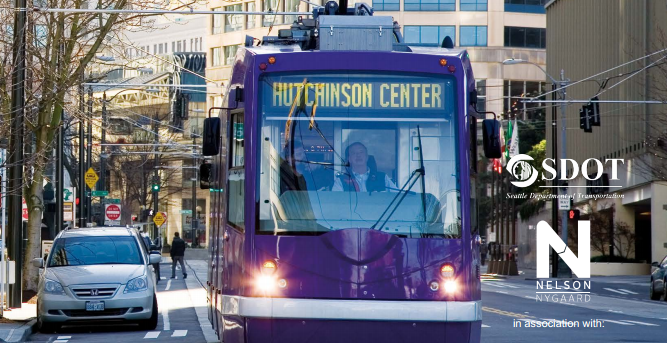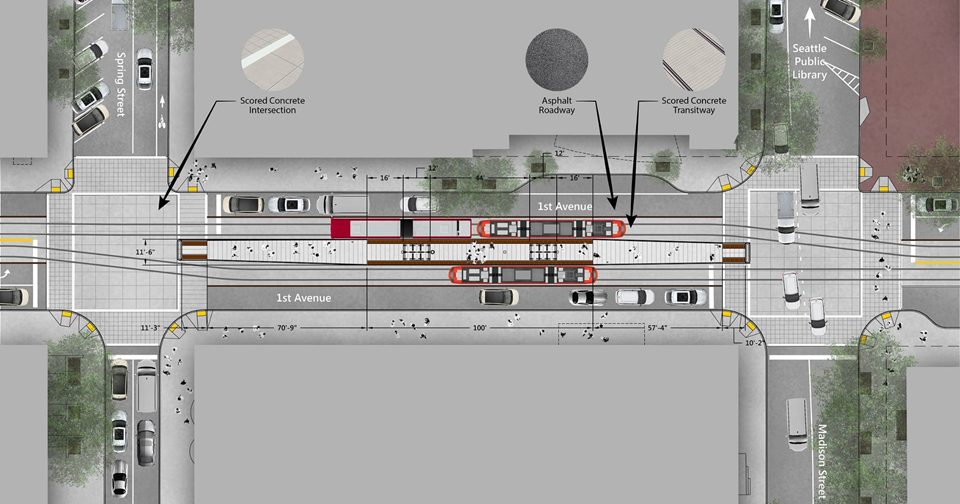On October 14th, former Seattle City Councilmember Nick Licata wrote a blog post that may mislead enough people to stop an excellent local transit project that Seattle Subway has supported since its inception. Since publishing his post, “The Center City Connector Streetcar–A Solution Looking for A Problem,” the Seattle City Council is hearing from misinformed constituents and long-time streetcar detractors.
Please write to Seattle City Council by Thursday, October 19th at 12PM, and urge them to OPPOSE the budget provision to defund the Center City Connector: Council@seattle.gov.
The detractors claim they cannot identify the problems the Center City Connector is trying to solve, so we thought we’d assist. Below are five top-level benefits of the Seattle Streetcar:
- Buses will be removed from the Downtown Seattle Transit Tunnel (DSTT) as early as 2019. The curbs at 2nd, 3rd, and 4th Avenues at Pike Street lack the necessary capacity to serve riders connecting between the International District and South Lake Union. Currently, DSTT buses serve many trips that are within the core alone, from the International District to Westlake Center. The Center City Connector expands capacity to 25,000 daily riders by connecting South Lake Union, International District, and First Hill.
- Anyone travelling from Capitol Hill to Westlake Center would likely not take the First Hill Streetcar, but light rail doesn’t serve Colman Dock or Pike Place Market directly. The Center City Connector is the last mile connection with five-minute frequencies to destinations, including South Lake Union, Pike Place Market, Colman Dock, Pioneer Square, the stadiums, and Chinatown/International District. The Center City Connector will also catalyze the BRT network that will expand access across the City. The Center City Connector is currently designed to share a platform at 1st and Madison with future Madison BRT buses. The infrastructure we build on 1st Avenue now can and should be shared by more BRT buses as the BRT network expands all over Seattle in the future.
- Detractors suggest that the Center City Connector is only an economic development tool for certain businesses along the line. While businesses within a three-block radius of streetcar lines tend to benefit more than others further from the route, the real economic benefit stems from moving a large quantity of people through the urban core with an accessible, easy-to-navigate mode. For visitors or first-time transit riders, rails in the ground are intuitive compared to learning a comprehensive bus system run by separate transit agencies. In 2011, the streetcar line saw 12.1 million visitors within a ⅛-mile radius. Providing dedicated transit lanes enables 25,000 daily riders to travel from one end of Downtown to the other in 6.1 minutes during the PM peak by 2030. Try doing that on the 3rd Avenue bus corridor today.
- Some suggest that this project won’t increase the ease of getting to work Downtown for underrepresented people while stating 1st Avenue residents and businesses would be inconvenienced by the construction. The Center City Connector has the ability to improve transit options for people who rely on transit. Transit-dependent riders skew towards lower income, people of color, people with limited mobility, and people seeking hourly wages. The new CAF streetcar vehicles are 100% low-floor and enable people with limited mobility to board independently from curb level. Additionally, the Center City Connector will serve as a last-mile connector for those commuting to the 37% of hourly wage jobs located in Downtown Seattle. Appealing to the constituents who would never want 1st Avenue torn up for any project is easy, but these voices go directly against our city’s interest. With this project, Seattle’s interest is as simple as moving people around. Those who chose to live in the vibrant core of our city share the responsibility of building the infrastructure to make it accessible and inclusive to all.
- The argument suggesting that capital dollars could be better used for bus operations is false. Overlooked is the fact that if Seattle fails to follow through on our commitment to federal funds, it has a ripple effect on funding existing projects with the federal government, including critical BRT lines. Many of those BRT improvements also include bike and safe streets infrastructure. At stake is $185 million in bus funding if we choose not move forward with the Center City Connector, including:
- Madison BRT – a $60 million project given high priority by the Federal Transit Administration (FTA) tied to a FY2018 spending bill being considered by Congress.
- Roosevelt BRT – a $35 million project submitted to FTA for review in the Spring of 2018.
- Rainier BRT – an estimated $50 million project beginning planning phase this spring and will be submitted to FTA in September 2018.
- Fremont/Ballard BRT – an estimated $40 million project submitted to the FTA in September 2019.
If you’re still on the fence, here are five fast facts that support the Center City Connector (CCC):
- CCC will build exclusive right-of-way downtown for transit and attracts a big ($75 million) federal investment of $177 million cost, which includes roadway and utility work.
- CCC hits high value destinations and is projected to move 25,000 people per day.
- CCC will have a lower cost per boarding than Metro buses.
- CCC is far more reliable transit than separate South Lake Union (SLU) and First Hill Streetcar (FHSC) lines and it will give both routes more access. CCC is more than just a connector; it’s a high-frequency, reliable trunk line that completes a transit line, which links SLU/FHSC. It also allows more transit routes to serve the core in the future.
- CCC is very reliable, frequent transit that has exclusive use of the center lanes of 1st Avenue and runs every 5 minutes.
US Senator Patty Murray has had tough fights with Republicans to secure our region federal funding. We don’t need to undermine those efforts locally. Please write to Seattle City Council by Thursday, October 19th at noon, and urge them to NOT support the budget proviso to defund the Center City Connector: Council@seattle.gov







